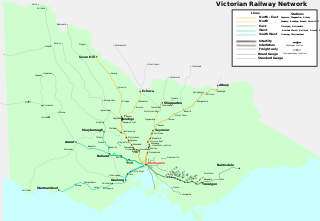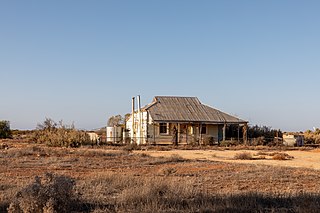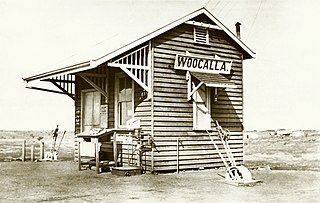
Rail transport is a means of transport that transfers passengers and goods on wheeled vehicles running on rails, which are incorporated in tracks. In contrast to road transport, where the vehicles run on a prepared flat surface, rail vehicles are directionally guided by the tracks on which they run. Tracks usually consist of steel rails, installed on sleepers (ties) set in ballast, on which the rolling stock, usually fitted with metal wheels, moves. Other variations are also possible, such as "slab track", in which the rails are fastened to a concrete foundation resting on a prepared subsurface.

In rail transport, a train is a series of connected vehicles that run along a railway track and transport people or freight. Trains are typically pulled or pushed by locomotives, though some are self-propelled, such as multiple units. Passengers and cargo are carried in railroad cars, also known as wagons. Trains are designed to a certain gauge, or distance between rails. Most trains operate on steel tracks with steel wheels, the low friction of which makes them more efficient than other forms of transport.

Victoria is an incorporated town in Lunenburg County, Virginia, United States. The population was 1,725 at the 2010 census, which was down from the 1,821 reported in 2000.

The Nullarbor Plain is part of the area of flat, almost treeless, arid or semi-arid country of southern Australia, located on the Great Australian Bight coast with the Great Victoria Desert to its north. It is the world's largest single exposure of limestone bedrock, and occupies an area of about 200,000 square kilometres (77,000 sq mi). At its widest point, it stretches about 1,100 kilometres (684 mi) from east to west across the border between South Australia and Western Australia.

A steam locomotive is a locomotive that provides the force to move itself and other vehicles by means of the expansion of steam. It is fuelled by burning combustible material to heat water in the locomotive's boiler to the point where it becomes gaseous and its volume increases 1,700 times. Functionally, it is a steam engine on wheels.

The Snowdon Mountain Railway is a narrow gauge rack and pinion mountain railway in Gwynedd, north-west Wales. It is a tourist railway that travels for 4.7 miles (7.6 km) from Llanberis to the summit of Snowdon, the highest peak in Wales.

The Ghan is an experiential tourism oriented passenger train service that operates between the northern and southern coasts of Australia, through the cities of Adelaide, Alice Springs and Darwin on the Adelaide–Darwin rail corridor. Operated by Journey Beyond Rail Expeditions, its scheduled travelling time, including extended stops for passengers to do off-train tours, is 53 hours 15 minutes to travel the 2,979 kilometres (1,851 mi). The Ghan has been described as one of the world's great passenger trains.

The Indian Pacific is a weekly experiential tourism passenger train service that runs in Australia's east–west rail corridor between Sydney, on the shore of the Pacific Ocean, and Perth, on the shore of the Indian Ocean – thus, like its counterpart in the north–south corridor, The Ghan, one of the few truly transcontinental trains in the world. It first ran in 1970 after the completion of gauge conversion projects in South Australia and Western Australia, enabling for the first time a cross-continental rail journey that did not have a break of gauge.

Indian Railways (IR) is a statutory body under the ownership of Ministry of Railways, Government of India that operates India's national railway system. It manages the fourth largest national railway system in the world by size, with a total route length of 68,103 km (42,317 mi) as of 31 March 2022. 52,247 km (32,465 mi) or 83% of all the broad-gauge routes are electrified with 25 kV 50 Hz AC electric traction as of 1 April 2022.

Cook is a railway station and crossing loop located in the Australian state of South Australia on the Trans-Australian Railway. It is about 826 kilometres (513 mi) west by rail from Port Augusta and about 100 kilometres (62 mi) north of the Eyre Highway via an unsealed road. It is on the longest stretch of straight railway in the world, at 478 kilometres (297 mi), which extends from Ooldea, South Australia to beyond Loongana, Western Australia.

Rail transport in Victoria, Australia, is provided by a number of railway operators who operate over the government-owned railway lines. The network consists of 2,357 km of Victorian broad gauge lines, and 1,912 km of standard gauge freight and interstate lines; the latter increasing with gauge conversion of the former. Historically, a few experimental 762 mm gauge lines were built, along with various private logging, mining and industrial railways. The rail network radiates from the state capital, Melbourne, with main interstate links to Sydney and to Adelaide, as well as major lines running to regional centres, upgraded as part of the Regional Fast Rail project.

The Trans-Australian Railway, opened in 1917, runs from Port Augusta in South Australia to Kalgoorlie in Western Australia, crossing the Nullarbor Plain in the process. As the only rail freight corridor between Western Australia and the eastern states, the line is strategically important. The railway includes the world's longest section of completely straight track.

The motive power depot (MPD) or locomotive depot, or traction maintenance depot (TMD), is the place where locomotives are usually housed, repaired and maintained when not being used. They were originally known as "running sheds", "engine sheds" or, for short, just sheds. Facilities are provided for refuelling and replenishing water, lubricating oil and grease and, for steam engines, disposal of the ash. There are often workshops for day to day repairs and maintenance, although locomotive building and major overhauls are usually carried out in the locomotive works.

Rawlinna is an isolated locality on the Trans-Australian Railway in Western Australia, about 900 kilometres east of Perth and 350 kilometres west of the Western Australia / South Australia border. It is on the Nullarbor Plain, about 50 kilometres from its western fringe; the topography is flat and well grassed, with saltbush and bluebush, with small belts of myall and myoporum trees. Annual rainfall is 288 millimetres. Maximum daytime temperatures are typically 38 °C (100 °F) through summer and 19 °C (66 °F) during winter. In 2016, the population in the area was recorded as 30 people.

Australia's National Railway Museum is the largest railway museum in Australia. More than 100 major exhibits, mainly from the South Australian Railways (SAR) and Commonwealth Railways and their successor, Australian National, are on display at its 3.5 hectares site in Port Adelaide, South Australia. The museum opened at Lipson Street in 1988 after 18 years at the SAR's former main locomotive depot at Mile End.

Forrest is a former small railway settlement and stopping place on the Nullarbor Plain, 88 kilometres west of the Western Australia / South Australia state border. It was established in 1916 during construction of the Trans-Australian Railway. The 2016 census recorded no residents. In the 2021 census, the area had "no people or a very low population".
Kingoonya, historically spelt Kingoonyah, was a small settlement, or township, now almost totally abandoned, in the central outback of the Australian state of South Australia. It was established in 1916 as a railway settlement on the Trans-Australian Railway, mainly to provide refuelling for steam trains and track maintenance services; it also served about 200 families living on sheep grazing properties in the region.
The Rand railway line is a closed railway line in New South Wales, Australia. The line ran for 53 km south-west to the town of Rand from the Main South railway line at Henty.

Cambodia has 612 km (380 mi) of 1,000 mm metre gauge rail network, consisting of two lines: one from the capital Phnom Penh to Sihanoukville, and another from Phnom Penh to Poipet on the Thai border. The lines were originally constructed during the time when the country was part of French Indochina, but due to neglect and damage from civil war during the latter half of the 20th century, the railways were in a dilapidated state and all services had been suspended by 2009. Through rehabilitation efforts by the Government of Cambodia, with funding from the Asian Development Bank, Australian Agency for International Development (AusAID) and Australian company Toll Holdings, freight and limited passenger service returned between Phnom Penh and Sihanoukville by 2016, and passenger service between Phnom Penh and Poipet was fully restored in 2019.

When the Trans-Australian Railway was completed in 1917 from Kalgoorlie to Port Augusta, about 50 settlements of various sizes were established along the line, from which maintenance workers kept the track in operational condition. They and their families led an isolated life, although they were supplied with provisions by a weekly special train, which also provided banking and postal facilities. Passenger trains were hauled by steam locomotives, which needed to take on water at various stopping places. With a change to diesel locomotives in the early 1950s, the need for such stops decreased greatly. Subsequently, upgrading to concrete sleepers and continuously welded rail reduced track inspection and maintenance considerably. Since 2001, maintenance work has been undertaken by contractors whose families do not live on the line.




















